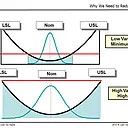A useful ( but not commonly mentioned) tool in Lean Six Sigma is called Little’s Law.
Little’s Law describes the fundamental long-term relationship between Work-In-Process, throughput and flow time of a production system in a steady state: As an equation Little’s Law can be written as :
Inventory =Throughput × Flow Time
Little’s law is both fundamental and simple and should be understood all all practitioners of Lean Six Sigma. It is fundamental to the creation of steady flow and reduction of inventory and WIP. Because it relates three critical performance measures of any production system, it is a basic Lean principle. Let’s look at an example : If we observe a milling machine that cuts 100 parts per hour with a queue of 800 parts in front if it, we say that it has “8 hours of WIP”. In speaking of WIP in terms of time, we are making use of Little’s law, which can be thought of as a conversion of units. Inventory is measured in pieces, flow time in hours, and throughput in pieces per hour. Hence, if we divide inventory by throughput we get flow time. So, to convert 800 pieces to the time it will take to process them, we divide by the throughput (100 pieces per hour) to get 8 hours. This conversion is useful when diagnosing a plant. If we see what physically looks like a large amount of inventory in the system, we cannot tell whether this is a signal of trouble until we know how much time is represented by the inventory. For instance, if we see 2000 pieces of WIP in a system that produces 10 per day, this is probably a disastrous system, while 2000 pieces in a system that produces 1000 per hour is probably extremely lean. Little’s law applies to single stations, production lines, factories, and entire supply chains. It applies to systems with and without variability. It applies to single and multiple product systems. It even applies to non-production systems where inventory represents people, financial orders, or other entities. Generally speaking, there are only two requirements for Little’s law to hold: WIP and Inventory Reduction: Since Little’s law implies that for a line Flow Time = WIP/Throughput, it is clear that reducing WIP while holding throughput constant will reduce flow time. One might be tempted to conclude that WIP reduction will always reduce cycle time. However, we must be careful. Reducing WIP in a line without making any other changes will also reduce throughput. For this reason, simply reducing inventory is not enough to achieve a lean manufacturing system. An integral part of any lean manufacturing implementation is a variability reduction effort, to enable a line to achieve the same (or greater) throughput with less WIP.














